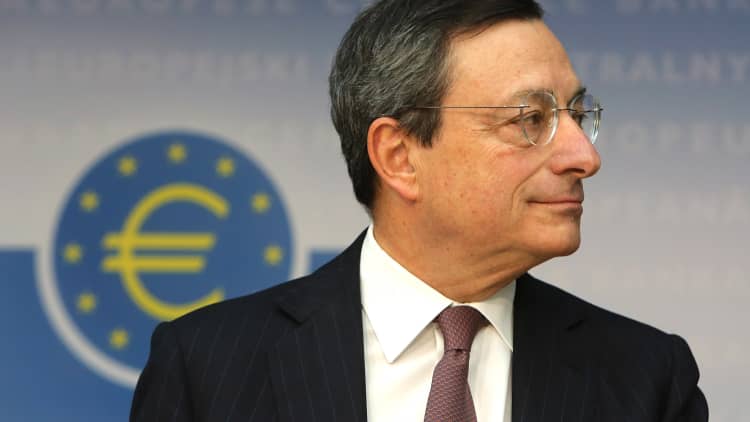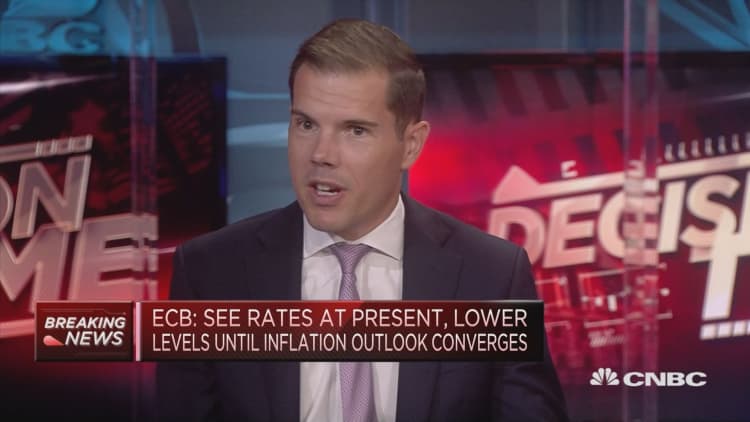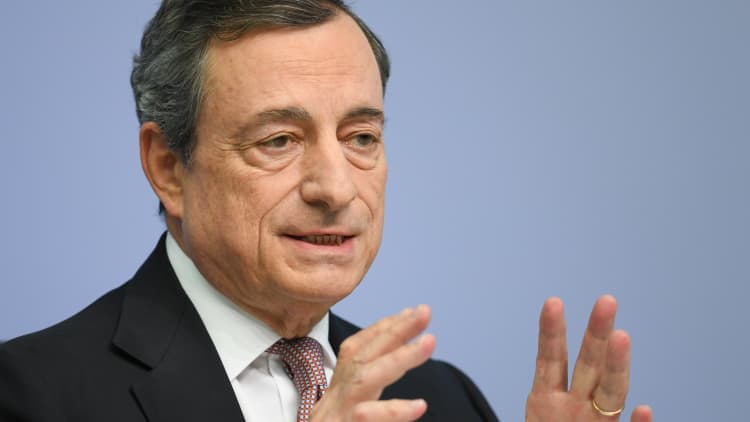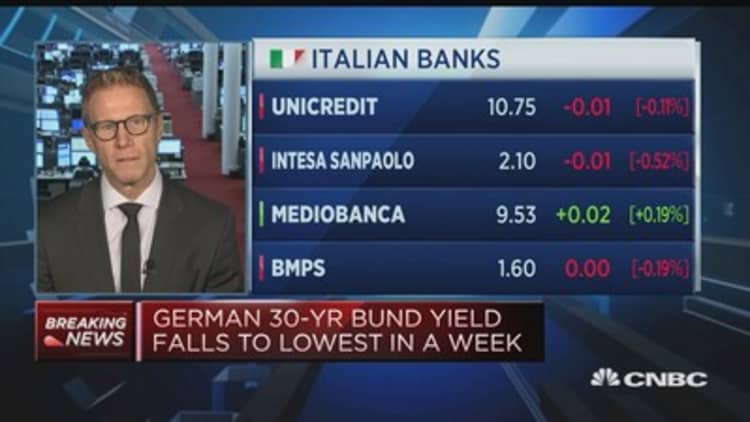
The European Central Bank (ECB) announced a massive new bond-buying program Thursday in a bid to stimulate the ailing euro zone economy.
The central bank's quantitative easing (QE) program will entail 20 billion euros ($21.9 billion) per month of net asset purchases for as long as it deems necessary.
The ECB also cut its main deposit rate by 10 basis points to -0.5%, a record low but in line with market expectations.
It now expects interest rates to remain at their present or lower levels until it has seen its inflation outlook "robustly converge to a level sufficiently close to but below 2% within its projection horizon, and such convergence has been persistent."
In a press conference following the decision, ECB President Mario Draghi urged governments to take fiscal measures to supplement the central bank's monetary stimulus and reinvigorate the euro zone economy.
"In view of the weakening economic outlook and the continued prominence of downside risk, governments with fiscal space should act in an effective and timely manner," Draghi said.
"In countries where public debt is high, governments need to pursue prudent policies that will create the conditions for automatic stabilizers to operate freely. All countries should reinforce their efforts to achieve a more growth-friendly composition of public finances," he added.

Additionally, the ECB changed its TLTRO (targeted long-term refinancing operations) rate to provide more favorable bank lending conditions and match that of its refinancing rate, erasing a previous 10 basis point spread.
A new system will see borrowers receive preferential rates if their eligible net lending exceeds a benchmark, providing an incentive for banks to use that money.
In line with market expectations, the ECB also introduced a two-tier rate system, a measure encouraged by the heads of various major European banks during the latest earnings season. The move is intended to alleviate some of the pressure of negative interest rates on the balance sheets of European banks, which have seen profits squeezed by the persistent low rate environment.
Draghi added in his press conference: "In order to support the bank-based transmission of monetary policy, the Governing Council decided to introduce a two-tier system for reserve remuneration, in which part of banks' holdings of excess liquidity will be exempt from the negative deposit facility rate."
'Draghi's final stunt'
Markets had widely expected some form of stimulus package, though hawks within the European Central Bank (ECB) Governing Council had moved in recent weeks to downplay the scale of the impending measures.
A slowing euro zone economy, persistent low inflation and the U.S.-China trade war had all pointed toward the central bank being forced to inject stimulus.
Recent economic data has not been promising, though the latest Purchasing Managers' Indexes (PMIs) had indicated some stability despite enduring industrial weakness.
This will be the second round of QE from the ECB, the first coming four years ago in response to the chaotic fallout of the euro zone sovereign debt crisis.

Outgoing President Mario Draghi will be hoping his final policy decision at the helm will help the bloc avoid a recession and get growth and inflation back on track.
Incoming replacement Christine Lagarde has already called for more fiscal stimulus to complement the ECB's policy.
ING Chief Economist Carsten Brzeski said in a note Thursday that "despite all market excitement now, the question remains whether this will be enough to get growth and inflation back on track as the real elephant in the room is fiscal policy."
"It is clear that without fiscal stimulus, Draghi's final stunt will not necessarily lead to a happy end," Brzeski added.
Market reaction
The pan-European Stoxx 600 index jumped 0.6% immediately after the first announcement, as markets reacted positively to ECB President Mario Draghi delivering on expectations of a "bazooka" stimulus package.
Euro zone bond yields tumbled and the euro weakened as a result of the new measures. Germany's benchmark 10-year bond yield tumbled 8 basis points to -0.64% while the euro slid back below $1.10.
European banking stocks plunged, however, giving back early gains to slip 0.9% below the flatline.

Artur Baluszynski, head of research at Henderson Rowe, said the ECB pushing rates further into negative territory is "essentially a tax on euro zone banks, and for the already weakened bank-financed economy like the euro zone, this move could spell more trouble."
"Also, with the Fed still being the tightest of the G-7 central banks, the eurodollar liquidity could come under pressure adding further stress to the increasingly challenged European banking system," he added.

